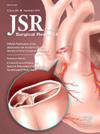Comparing the Effectiveness of Open, Laparoscopic, and Robotic Gastrectomy in the United States: A Retrospective Analysis of Perioperative, Oncologic, and Survival Outcomes
IF 1.8
3区 医学
Q2 SURGERY
引用次数: 0
Abstract
Introduction
Minimally invasive surgery (MIS) is increasingly used in the surgical management of gastric cancer; however, its adoption lags that of other cancers. Most randomized controlled trials comparing MIS to open gastrectomy have been conducted in Asia, with limited data from the United States. This study aimed to compare perioperative, oncologic, and survival outcomes between open, laparoscopic, and robotic gastrectomy in a large US cohort.
Methods
Using the National Cancer Database, we identified patients with gastric adenocarcinoma who underwent open, laparoscopic, or robotic gastrectomy between 2010 and 2020. Multivariate regression models were used to examine the association between surgical approach and various outcomes, including 30-d readmission, length of stay (LOS), surgical margin status, lymph node yield, 30- and 90-d mortality, and overall survival (OS). The interaction between surgical approach and tumor location (distal versus proximal or gastroesophageal junction [GEJ]) was also assessed.
Results
Of the 34,937 included patients, 64.8% underwent open gastrectomy, 25.7% underwent laparoscopic surgery, and 9.5% underwent robotic surgery. MIS was associated with lower odds of 30-d readmission (laparoscopic: odds ratio [OR] 0.78, 95% confidence interval [CI] 0.67-0.89; robotic: OR 0.75, 95% CI 0.60-0.92), positive margins (laparoscopic: OR 0.83, 95% CI 0.74-0.93; robotic: OR 0.75, 95% CI 0.62-0.90), 30-d mortality (laparoscopic: OR 0.69, 95% CI 0.55-0.85; robotic: OR 0.66, 95% CI 0.44-0.95), and 90-d mortality (laparoscopic: OR 0.74, 95% CI 0.63-0.87; robotic: OR 0.63, 95% CI 0.47-0.84), as well as improved OS (laparoscopic: hazard ratio 0.83, 95% CI 0.79-0.87; robotic: hazard ratio 0.76, 95% CI 0.69-0.83) compared to open surgery. Considering the interaction of approach with tumor location, for proximal/GEJ tumors, the associated outcome improvements with MIS were attenuated. We observe that the odds for 30-d readmission, 90-d mortality, and OS are similar to those for open operations. However, regardless of tumor location, robotic gastrectomy was associated with decreased LOS and yielded a higher lymph node count than laparoscopic or open approaches.
Conclusions
In this large US cohort, MIS gastrectomy was associated with improved perioperative, oncologic, and survival outcomes compared to open surgery for distal gastric cancers. However, the associated benefits of MIS were attenuated for proximal/GEJ tumors, with higher odds of readmission, mortality, and worse OS. Notably, robotic gastrectomy was associated with superior lymph node yield and LOS compared to laparoscopic and open approaches, even for proximal/GEJ tumors. These findings underscore the need for further research, especially randomized controlled trials conducted in Western populations, to definitively determine the efficacy of MIS for distal and proximal/GEJ tumors and guide surgical decision-making for gastric adenocarcinoma.
比较美国开腹、腹腔镜和机器人胃切除术的效果:围手术期、肿瘤学和生存结果的回顾性分析。
导言:微创手术(MIS)越来越多地用于胃癌的外科治疗,但其应用却落后于其他癌症。大多数比较微创手术和开腹胃切除术的随机对照试验都是在亚洲进行的,来自美国的数据有限。本研究旨在比较美国大样本中开腹胃切除术、腹腔镜胃切除术和机器人胃切除术的围手术期、肿瘤学和生存结果:我们利用美国国家癌症数据库,确定了2010年至2020年间接受开腹、腹腔镜或机器人胃切除术的胃腺癌患者。我们使用多变量回归模型研究了手术方式与各种结果之间的关系,包括 30 天再入院率、住院时间(LOS)、手术边缘状态、淋巴结转移率、30 天和 90 天死亡率以及总生存率(OS)。此外,还评估了手术方法与肿瘤位置(远端与近端或胃食管交界处[GEJ])之间的相互作用:结果:在纳入的 34,937 例患者中,64.8% 接受了开腹胃切除术,25.7% 接受了腹腔镜手术,9.5% 接受了机器人手术。MIS 与较低的 30 天再入院几率相关(腹腔镜:几率比 [OR] 0.78,95% 置信区间 [CI]0.67-0.89;机器人:几率比 [OR] 0.75,95% 置信区间 [CI]0.67-0.89):OR为0.75,95% CI为0.60-0.92)、边缘阳性(腹腔镜:OR为0.83,95% CI为0.74-0.93;机器人:OR为0.75,95% CI为0.62-0.90)、30天死亡率(腹腔镜:OR为0.69,95% CI为0.55-0.85;机器人:OR为0.66,95% CI为0.44-0.95)和90天死亡率(腹腔镜:OR为0.69,95% CI为0.55-0.85;机器人:OR为0.66,95% CI为0.44-0.95)均较低。95)和90天死亡率(腹腔镜:OR 0.74,95% CI 0.63-0.87;机器人:OR 0.63,95% CI 0.47-0.84),与开腹手术相比,OS(腹腔镜:危险比0.83,95% CI 0.79-0.87;机器人:危险比0.76,95% CI 0.69-0.83)也有所改善。考虑到手术方式与肿瘤位置的交互作用,对于近端/GEJ肿瘤,MIS手术的相关预后改善有所减弱。我们观察到,30 天后再入院、90 天后死亡率和 OS 的几率与开放手术相似。然而,与腹腔镜或开腹手术相比,无论肿瘤位置如何,机器人胃切除术都能缩短住院时间并获得更高的淋巴结计数:结论:在这一大型美国队列中,与开腹手术相比,MIS胃切除术可改善远端胃癌的围手术期、肿瘤学和生存率。然而,对于近端/GEJ肿瘤,MIS的相关益处有所减弱,再入院几率更高、死亡率更高、OS更差。值得注意的是,与腹腔镜和开腹方法相比,机器人胃切除术的淋巴结产量和LOS都更高,即使是近端/GEJ肿瘤也是如此。这些发现强调了进一步研究的必要性,尤其是在西方人群中开展随机对照试验,以明确确定 MIS 对远端和近端/GEJ 肿瘤的疗效,并指导胃腺癌的手术决策。
本文章由计算机程序翻译,如有差异,请以英文原文为准。
求助全文
约1分钟内获得全文
求助全文
来源期刊
CiteScore
3.90
自引率
4.50%
发文量
627
审稿时长
138 days
期刊介绍:
The Journal of Surgical Research: Clinical and Laboratory Investigation publishes original articles concerned with clinical and laboratory investigations relevant to surgical practice and teaching. The journal emphasizes reports of clinical investigations or fundamental research bearing directly on surgical management that will be of general interest to a broad range of surgeons and surgical researchers. The articles presented need not have been the products of surgeons or of surgical laboratories.
The Journal of Surgical Research also features review articles and special articles relating to educational, research, or social issues of interest to the academic surgical community.

 求助内容:
求助内容: 应助结果提醒方式:
应助结果提醒方式:


